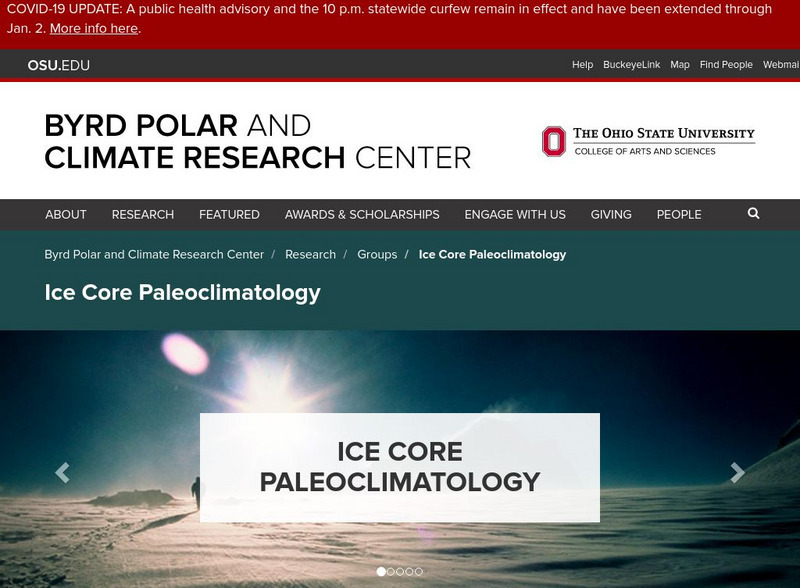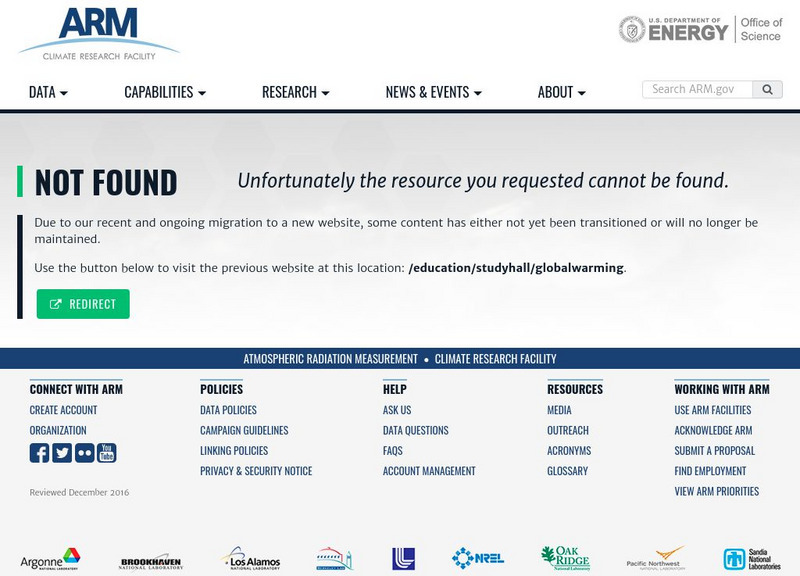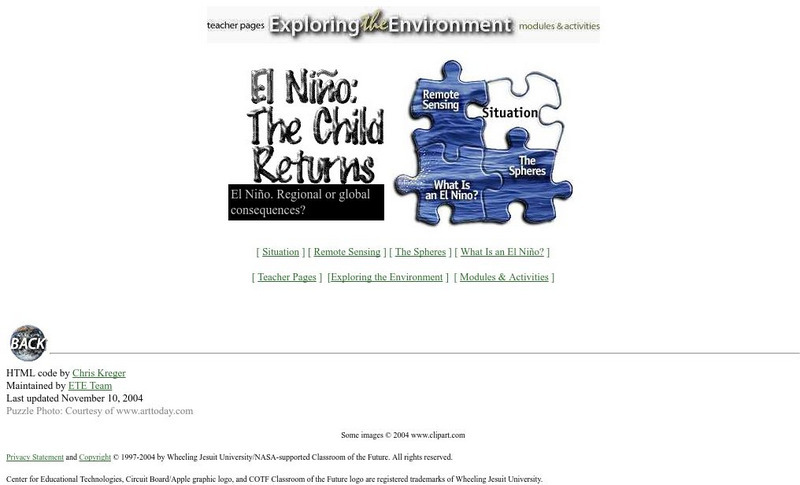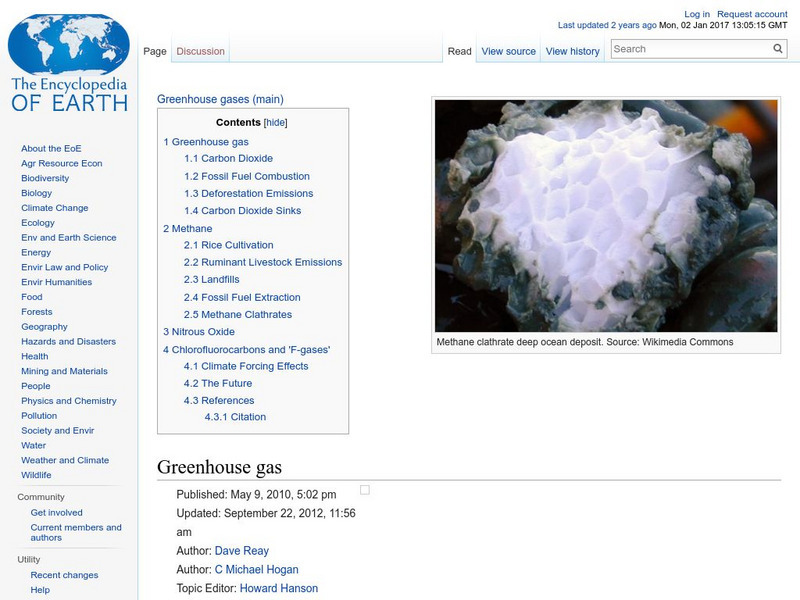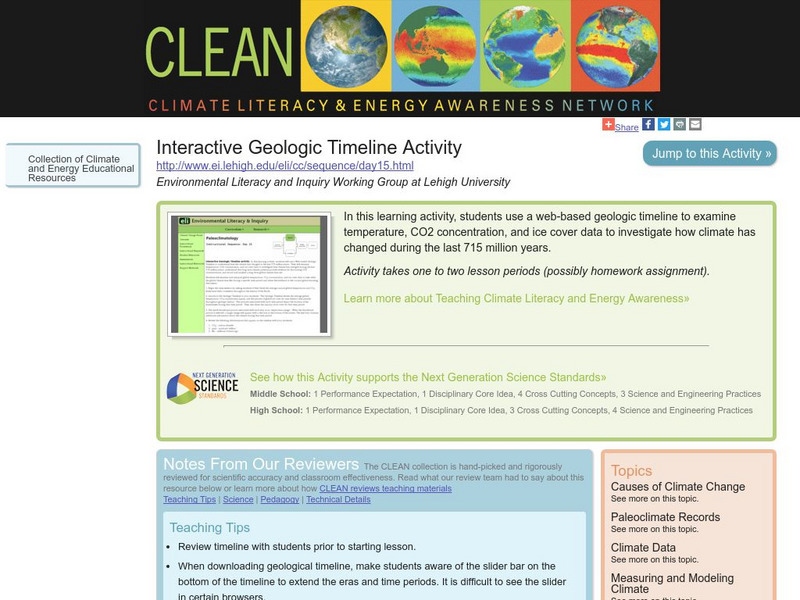Hi, what do you want to do?
University of California
Understanding Science: Cold Fusion: A Case Study for Scientific Behavior
Major issue--the energy sources currently available to the world all have major drawbacks in the long term. Oil is efficient but leads to climate change. Coal is plentiful but polluting. Solar energy is appealing but only as dependable...
US Geological Survey
Lake Pontchartrain Basin Foundation: The Forces Are With Us: Natural Forces
A collection of science activities that focus on natural forces that affect Lake Pontchartrain Basin. Students will understand how global climate change relates to storm events, subsidence, and erosion. Background information on...
Climate Literacy
Clean: Introduction to Earth's Climate
This lesson is an introduction to Earth's climate and covers key principles regarding Earth's unique climate, atmosphere, and regional and temporal climate differences. Students will gain an understanding of how the weather and climate...
NASA
Nasa: Climate Kids: What Is the Big Deal With Carbon?
An illustrated article highlighting the science behind carbon and fossil fuels. Diagrams and graphs help with understanding.
Ohio State University
Byrd Polar Research Center: Ice Core Paleoclimatology Research Group
This site explains the research of the Ice Core Paleoclimatology Group. See how they are coring ice samples all around the world to help better understand Earth's changing climate. Provides links to teaching materials.
Other
Arm Program's Education Center: Global Warming
An all purpose site with something for everyone. Learn about global warming and climate change, ask a scientist, take a quiz, or get a lesson plan!
Climate Literacy
Clean: Public Service Announcement (Psa) for Grades 6 12
Students study climate change and create a Public Service Announcement that communicates their understanding of the science, raises awareness about climate change, and motivates people to take action.
Center for Educational Technologies
Exploring the Environment El Nino: The Child Returns
Use remote sensing data and background information to look at regional and global consequences of El Nino. Try working with the 'situation' to test your understanding.
Center for Educational Technologies
Cet: Exploring the Environment: Human Health Effects
As an epidemiologist on the U.S. Panel for Climate Change, students are tasked with analyzing the latest data on climate-impacted human health conditions. A solid understanding of the mechanisms underlying the connections will allow for...
Encyclopedia of Earth
Encyclopedia of Earth: Greenhouse Gas
Explains what greenhouse gas is, how the greenhouse effect works, and the history of fossil fuel combustion. Causes of other damaging greenhouse gases, including methane, nitrous oxide, chlorofluoracarbons, hydrofluorocarbons, and...
NASA
Nasa: Earth Observatory: The Carbon Cycle
Learn about the element carbon and its importance on the Earth's atmosphere and sustainability of life on the planet. Additionally, understand the role the carbon cycle plays in global climate change over time.
University Corporation for Atmospheric Research
Ucar: Little Ice Age: Blooming Thermometers
In this instructional activity, students develop an understanding of the relationship between natural phenomena, weather, and climate change, the study known as "phenology." In addition, they learn how cultural events are tied to the...
University Corporation for Atmospheric Research
Ucar: Torrents, Droughts, and Twisters Oh My!
Young scholars review what scientists know and what they're working to understand about the relationship between extreme weather events and climate change.
NOAA
Noaa: Where Will the Polar Bears Go? [Pdf]
Get to know polar bears and learn why it is important for them to live in the current arctic conditions. Make a poster that demonstrates your understanding of how climate change in the arctic could affect polar bears and humans.
NASA
Climate Kids: What Do All These Graphs Mean?
Learn how to make, read and interpret a graph based on information regarding climate change. Understand the need to think globally and to take action!
Geography 4 kids
Geography4 kids.com: Variety Is the Spice of Climate
To every thing there is a season. Understand the role climate plays in the change of seasons across the United States.
Science Buddies
Science Buddies: Swimming in Acid: Understanding Ocean Acidification
The oceans are a precious natural resource, part of Earth's carbon cycle. But what happens if the oceans absorb too much carbon dioxide? Many scientists are concerned that the increased absorption of carbon dioxide is causing them to...
Society for Science and the Public
Science News for Students: Earth Breaks Heat Record for Third Year Straight
Climate change and heat from a strong El Nino played roles in making 2016 the hottest year on record. Understand the specific impacts of climate change.
Climate Literacy
Clean: Carbon Cycle Game
In this interactive, regionally-relevant carbon cycle game, students are challenged to understand the role of carbon in global climate change. They imagine that they are carbon molecules and travel via different processes through carbon...
Climate Literacy
Clean: Interactive Geologic Timeline Activity
In this learning activity, students use a web-based geologic timeline to examine temperature, CO2 concentration, and ice cover data to investigate how climate has changed during the last 715 million years. Students will gain an...
Government of Canada
Canadian Space Agency: Cloud Sat Looking at Clouds in 3 D
Learn about the mission of ClourSat, a satellite that will gather data as part of a comprehensive study of clouds to help develop a better understanding of the effect of clouds on climate . It will examine their structure, frequency and...
PBS
Pbs Learning Media: Albedo Decrease Linked to Vanishing Arctic Sea Ice
Examine this visualization by NASA to understand how the warming of the Arctic region has caused the sea ice extent to decline by 40%, thereby throwing our earth's energy budget off balance. Extensive resources included are teaching...
Choices Program, Brown University
Choices: Teaching With the News: Global Environment: Considering u.s. Policy
Through videos and handouts, students gain a better understanding of what U.S. policy should be concerning global environmental issues. They willexplore four divergent policy options on the question of U.S. global environment policy and...
Story Behind the Science
Story Behind the Science: Realization of Global Warming [Pdf]
Article describing the history of how scientists developed their current understanding of global warming. It discusses why it is difficult for some people to accept that human beings have caused the Earth to warm, without controlled...









